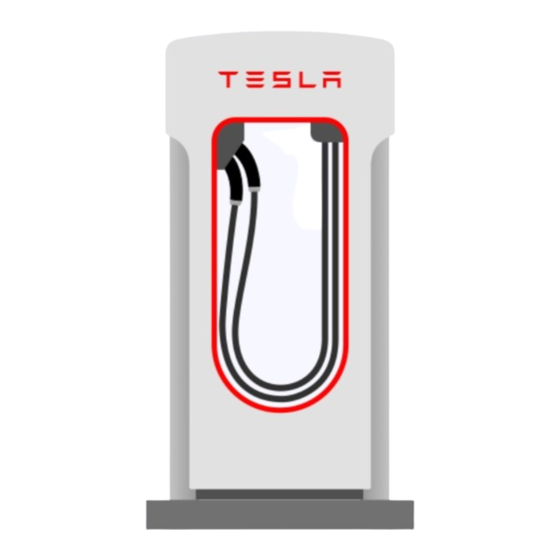
Advertisement
V2 SUPERCHARGER FIRST RESPONDER GUIDE
This guide does not apply to the new V3 Supercharger.
This guide is intended only for use by trained and certified rescuers and first responders. It assumes that
readers have a comprehensive understanding of how safety systems work and have completed the
appropriate training and certification required to safely handle rescue situations. Therefore, this guide
provides only the specific information required to understand and safely handle Tesla Supercharger
equipment in an emergency situation. It describes how to identify Supercharger equipment, and provides the
locations and descriptions of its high voltage components. This guide includes the high voltage disabling
procedure and any safety considerations specific to Supercharger equipment. Failure to follow
recommended practices or procedures can result in serious injury or death.
Supercharger equipment is constantly evolving, and multiple generations of hardware exist. The images in
this guide might not match the equipment you are working on. Any major changes regarding high voltage
components across equipment generations will be explicitly outlined in this guide.
Advertisement
Table of Contents

Summary of Contents for Tesla V2 SUPERCHARGER
- Page 1 Therefore, this guide provides only the specific information required to understand and safely handle Tesla Supercharger equipment in an emergency situation. It describes how to identify Supercharger equipment, and provides the locations and descriptions of its high voltage components.
-
Page 2: Table Of Contents
SUPERCHARGER EMERGENCY RESPONSE GUIDE SUPERCHARGER DEPLOYMENT Table of Contents Physical Damage to Electrical Switchgear or Transformer ..................... 3 How to Disconnect Power to the Entire Supercharger Site ....................4 How to Disconnect Power to a Single Supercharger Cabinet ....................6 General Site Layout ................................ -
Page 3: Physical Damage To Electrical Switchgear Or Transformer
SUPERCHARGER EMERGENCY RESPONSE GUIDE SUPERCHARGER DEPLOYMENT Physical Damage to Electrical Switchgear or Transformer BE AWARE OF ELECTRIC HAZARDS • Use extreme caution when approaching the scene of an electrical emergency, especially at night. • Contact local utility company to disconnect grid power coming into equipment. •... -
Page 4: How To Disconnect Power To The Entire Supercharger Site
• Do NOT attempt to disconnect power via the Tesla Supercharger Cabinets themselves (pictured below). Disconnecting power to the Supercharger Cabinets should always be done via the branch breakers in the switchgear, as described in the next section. - Page 5 SUPERCHARGER EMERGENCY RESPONSE GUIDE SUPERCHARGER DEPLOYMENT WARNING: Regardless of the disabling procedure you use, ALWAYS ASSUME THAT ALL HIGH VOLTAGE COMPONENTS ARE ENERGIZED! Cutting, crushing or touching high voltage components can result in serious injury or death.
-
Page 6: How To Disconnect Power To A Single Supercharger Cabinet
SUPERCHARGER EMERGENCY RESPONSE GUIDE SUPERCHARGER DEPLOYMENT How to Disconnect Power to a Single Supercharger Cabinet • Locate electrical switchgear for Supercharger Cabinets, typically inside an enclosure similar to what is pictured below. This enclosure is usually located within 100 feet of the station. •... -
Page 7: General Site Layout
SUPERCHARGER EMERGENCY RESPONSE GUIDE SUPERCHARGER DEPLOYMENT General Site Layout • A typical site layout is shown below. • No two sites are identical, but the enclosure usually contains the switchgear and the Supercharger cabinets. • The enclosure in most cases is located as close as possible to the Supercharger Posts. WARNING: Regardless of the disabling procedure you use, ALWAYS ASSUME THAT ALL HIGH VOLTAGE COMPONENTS ARE ENERGIZED! Cutting, crushing or touching high voltage components can result in serious injury or death. -
Page 8: Firefighting
SUPERCHARGER EMERGENCY RESPONSE GUIDE SUPERCHARGER DEPLOYMENT Firefighting Extinguish small fires that do not involve a high voltage battery, using a CO or ABC extinguisher. During overhaul, do not make contact with any high voltage component. Always use insulated tools for overhaul. High Voltage Labels Labels associated with high voltage equipment are shown below. - Page 9 ©2019 TESLA MOTORS, INC. All rights reserved. All information in this document is subject to copyright and other intellectual property rights of Tesla and its licensors. This material may not be modified, reproduced, or copied, in whole or in part, without the prior written permission of Tesla and its licensors.












Need help?
Do you have a question about the V2 SUPERCHARGER and is the answer not in the manual?
Questions and answers